Tattoo meaning
Tattoos that use the phrase "Memento Mori" are among the most popular and sought after. According to surveys, a large number of tattoo bearers with this phrase do not know its historical background.
The modern meaning of "Memento Mori" suggests the predetermination of life's path by higher forces. A person cannot change what is predetermined by Destiny. The second idea of the phrase is the finitude of existence.
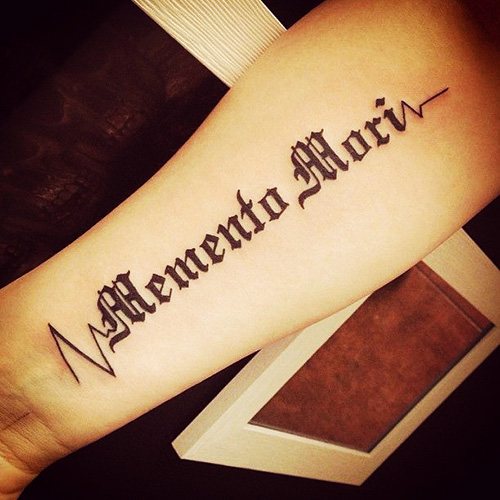
Nothing in this world is eternal and death is the logical continuation of life. That is why the phrase "Memento Mori" is so beloved by fans of the transience of existence and the predetermination of the future.
According to scientists at the University of Missouri, who have done a lot of research on thinking about death, have been able to find that:
- The awareness of death pushes people to altruism.
- The inevitability of death encourages care for nature.
- Understanding the onset of death makes people more tolerant.
- The finitude of life makes you question its meaning.
"Memento Mori" has become an iconic phrase long before it became ubiquitous on the body in the form of tattoos. Moreover, in ancient times it was rarely used with the prefix "Carpe diem.
The phrase owes its appearance to the Romans, who liked to honor their consuls for military victories with magnificent triumphs at the entrance to Rome. However, in addition to the bright greeting of the victor, a small role of the slave, whose duty was to stand behind the warlord and, holding a golden wreath above his head, constantly repeat: "Memento Mori," was included in the holiday scenario that could make the triumphant's head swell.
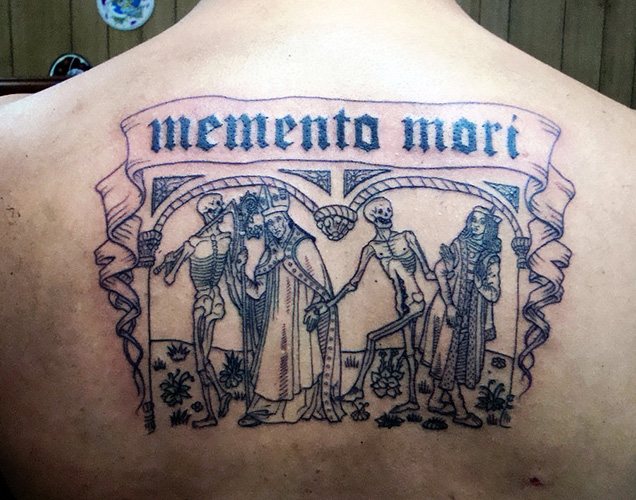

Carpe diem Memento Mori
So Roman citizens reminded him that he too was a man and that his life too would one day end. The expression "Memento mori" was used by the Roman poet Horace in his Ode to Leucone. In Quintus Septimius Florence Tertullian's Apologetics, who lived at the turn of the second and third centuries, the expression is mentioned in another formulation: "Respice post te! Hominem te memento! Memento mori", which translated means "Turn around! Remember that you are a human being! Remember that you are a human being!"
In the 17th century, during the formation of secret societies, the expression "Memento Mori" began to be used as a greeting to one another by the monks of the Brothers of Death.
For the last 300 years the phrase has been found in cemeteries at tombstones or crypts.
Memento mori or Remember that you are mortal
Memento mori and Carpe diem are winged phrases that remind us that nothing is eternal...
Death always evokes a sense of coldness, longing, and sad silence. For no matter how much fun we have living our lives, the outcome is still the same for everyone. Alchemists have not yet invented a cure for immortality, so it is always worth remembering the inevitable end.
In the vocabulary of educated and well-read people or individuals who like to stand out, it is often possible to hear such expressions as "memento mori" and "carpe diem". Let's try to understand their origin.
How is memento mori translated?
Memento mori is a winged expression that comes from the Latin language and literally translates into Russian as remembering death or remembering that you are mortal. Today the phrase "memento mori" means that nothing is eternal.
Often this phraseology is used when one wants to remind people that partying, drinking and debauchery are not the most important things in life. The expression is also relevant when a person worries a lot for any reason and without. The emphasis here is on the fact that no matter how much you strive for something, the result is the same for all.
In principle, memento mori represents a kind of warning to fussy and overly active people that eventually we will all die, and the emphasis in life should be on the important things.
History of the origin of the expression
The phrase memento mori was first mentioned in ancient Rome. It was uttered by Roman generals when they returned home with success. Behind the warlord's back was a slave who reminded him that despite victory, the leader was mortal.
The same phrase was exchanged by monks of the Trappist order in France in 1620-1633 when they met each other on their way. This order was a reformist branch of the Cistercians, which had separated from the Benedictines in the 11th century. They adhered to the rules of love of God and neighbor, respect for people, and also called for remembering the end of life, memento mori.
At this time in Europe there was a fashion for ritual objects and paraphernalia associated with death. This is most likely due to the fact that the region had experienced many misfortunes - the Asian plague, the Ice Age, the wave of venereal diseases and more. The options of how to die were numerous for the European resident of that time. In this connection, so-called "amulets" in the form of skulls, skeletons or even coffins were in demand among traders. They reminded of the inevitability of the end.
Later, such jewelry was worn by people whose close relative or friend had died.
How is "carpe diem" translated?
Another expression similar in theme to memento mori is carpe diem. It also comes from the Latin language and literally translates as "live for today" or "seize the moment.
The phrase is understood as a plea to live life to the fullest, without putting off all the fun for a future that may never come. Carpe diem is a kind of antonym to the expression memento mori. While the latter urges us to remember the end, the former urges us not to forget the present.
This phrase is often used as a justification for taking unexpected actions and making the most of opportunities in life. No one knows if tomorrow will come, so today we must act to the best of our ability.
It is not uncommon to see carpe diem as a tattoo on the arm or back of people who lead a free-spirited lifestyle, disappearing into nightlife entertainment venues.
Important moments of existence are often reflected in literary or colloquial language. Winged expressions or idioms are an example of this. Most often they are created on the basis of what worries people or what spheres cause controversial questions. Death and life are no exception.
Back to list
Expressions with the phrase Carpe diem
Carpe diem Memento Mori is a rather popular tattoo, because the ancient Roman expression gets a different meaning when using the phrase "Carpe diem". Translated from Latin, it means "catch the day".
The expression "Carpe diem" is first found in the "Ode to Leucono" along with the other half of the phrase being described. The two words were taken out of context by the Roman poet's descendants. The phrase was "Aetas: care diem, quam minimum credula postero" (time: catch the moment, believe as little as possible in the future).
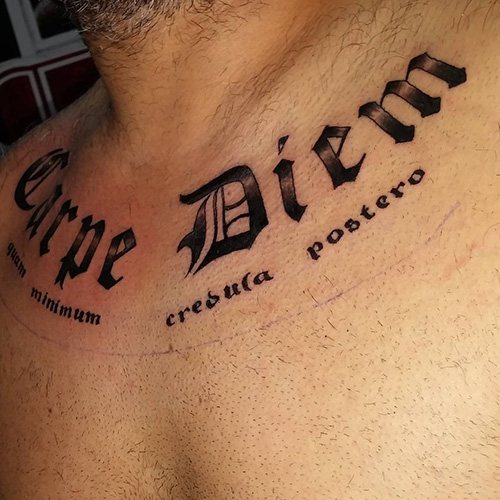

If "Memento Mori" hints to a man that his way is finite, the four-word phrase tells him that he must enjoy every day, every moment of his life, because tomorrow everything will be different. A new day brings new impressions, and yesterday cannot be returned. In ancient times, these two phrases were not interpreted in the same sense, although they are close to each other.
The expression "Carpe diem" is also used in the musical compositions of Lara Fabian, Metallica and Green Day. Features of the drawing, options Carpe diem Memento Mori tattoo is a tattoo, most often performed in the spirit of mysticism and eternal peace.
Therefore, drawings for tattoos very often have the following common features:
- Archaic font.
- The image of a skull or bones next to the text is a symbol of death.
- The image of a burning candle and an hourglass is a symbol of the finitude of existence.
- An abundance of black or dark colors when applying a tattoo.
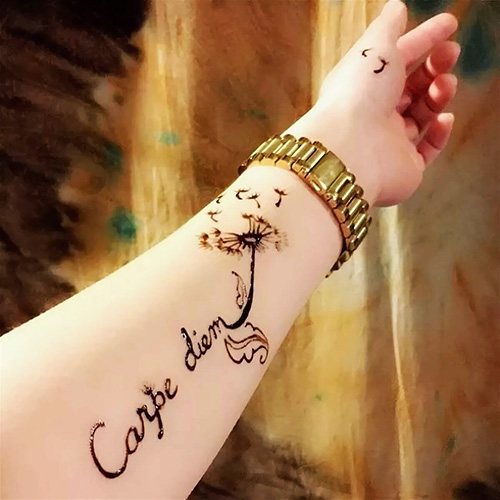

When forming the sketch of the future tattoo, masters sometimes use the idea of a pirate coin. A human skull placed in the middle is enclosed in a phrase inscribed on the circumference of the coin, which enriches the already capacious phrase with the spirit of privateering and piracy.
In combination with the phrase, an open book, most often the Bible, is often used as a symbolizing object. Located on the skull and the prisoner on the edges of the clock should always remind the bearer of the tattoo that the mundane life is not eternal, and the afterlife is ready to take all. The harbinger of imminent death, as well as just a wise bird is considered a raven. His image is often depicted in conjunction with the inscription.
The most courageous decision when applying the tattoo is the presence of a certain plot. Examples of this can be biblical subjects, pictures where the devil tempts a person, images of the end of the world or a meeting with the Angel of Death. Drops of red blood on the background of the inscription "Memento Mori" will complete the mystical composition.
An image of a person (including a portrait of the tattoo owner) during life and a half-decayed body after death can be original. The mirror-like nature of the drawing will hint that no amount of wealth or influence will change the outcome of everyone's life. A person is born naked and leaves this world with nothing either. Nothing can be taken into the afterlife, and so it is important to remember death and live in a way that remains human.
Modern Meaning
Gradually, the original meaning of this winged expression began to be forgotten. Today there are so many bearers of the tattoo Memento Mori, who know nothing about this historical background. The modern meaning of this tattoo has two interpretations:
- Nothing is eternal in this world.
- Everything has long been predetermined by the higher forces.
That is why this inscription can be found in people who want to emphasize the perishability of existence and the inability of man to change his fate.
So if you want to score yourself this inscription, you can easily look at the photos of tattoo Memento Mori of any master and choose a variant that will suit you.
Fans of tattoo art often prefer to encrypt their mottos and principles of life in a tattoo inscription in Latin. This elegant, melodic language is one of the oldest written Indo-European languages.
Beautiful phrases in Latin in tattoos
On this guy's arms are two winged phrases in Latin: "Fac fideli sis fidelis
" which translates to "Be faithful to the one who is faithful (to you)" and "
Fortunam suam quisque parat
"Every man finds his own happiness" or "Every man finds his own destiny".
The tattoo, in beautiful script, reads: "Primus inter pares
"which translates as "First among equals."
«Carpe diem
"is a famous Latin expression that means "Live in the present", "Seize the moment".
«Vivere militate est
" is a saying of Seneca, which translates as "To live is to struggle.
Below are quotations and phrases in Latin that are suitable for use in tattoos.
Fonts and additional symbolism
Applying the phrase to the body, masters try to avoid simple and mediocre fonts. The melodious-sounding phrase is executed in a carved and graceful style. The letters branch and curve gently, symbolizing the curvature of life's journey. Varieties of Gothic script are also used for "Memento Mori", creating a connection of the phrase to medieval traditions and the activities of the Holy Inquisition, which had a direct bearing on the life and death of the Christian.
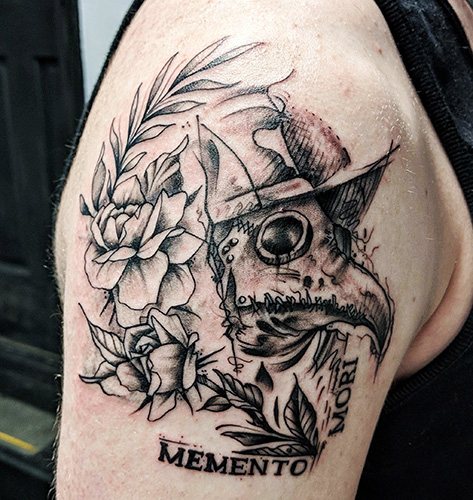

Old style antiqua allows you to recreate the spirit of the Renaissance, when life and death began to be perceived as a joint body and soul, which everyone must go through. Similar to this is the ambigram tattoo, which allows several themes and meanings to be embodied in the image at once.
Color drawings allow you to create abstract scenes with a 3D effect. A rich palette of shades that adorns the traditional drawing with a play of colors, creating the effect of convexity or concavity allows you to achieve such a thing.
In professional tattoo-salons masters can offer to put a phrase in their own decorative fonts or in unusual script, where the letters are put in italics. Experienced masters often offer to apply the image in the "thrash polka" style, which complements the images with realism. This effect is achieved by portrait painting, visual splashing and smearing of paints.


The tradition of minimalism is used to convey the hidden aura of the phrase. The restrained approach calls for humility and blind adherence to a fated destiny.
Who is suitable for the tattoo?
The tattoo with such an inscription is suitable for both men and women, although it is more popular among the stronger half of mankind.
Most often it is applied by people who:
- Religious;
- tend to believe in mysticism;
- think about tomorrow;
- care about their good name after death;
- live for today;
- enjoy every moment of life.
To such people, a tattoo serves as a kind of beacon or reference point. It encourages to improve oneself, one's human qualities and to remember that every person has his time on the Earth and one should use it correctly, because there will not be a second chance.
The main places of application
Carpe diem Memento Mori is a tattoo that can be applied to any part of the body. In combination with meaningful pictures that complement the meaning of the phrase, it can become a real decoration of the body and emphasize the individuality of its owner.
The most common places of application and the variants used are shown in the table:
| Body part | Inscription size | Accompanying symbols |
| Hand | Small/medium | Blood, skull |
| Foot | ||
| Chest | Any | Book, clock, skeleton, candle, coffin, Angel of Death |
| Back | Big | Wings, blood, Angel of Death |
| Neck | Small | No additional symbols |
This table is a confirmation of the universality of the phrase. The location of the tattoo should be so that it can be seen not only by the surrounding people, but also by the owner himself. This will help not to forget the main meaning of the mysterious phrase.


Carpe diem Memento Mori is not only famous all over the world, but also more and more often found in many people as a tattoo in many countries on all continents. Its popularity grows every year because of its capacity and versatility.
Author: Mikhail Pushkarev
History
This phrase has a very rich history. For the first time it was uttered back in the days of ancient Rome. One day a warlord was returning home after an important victory. At that time, one of his slaves followed him and repeated this phrase so that the warlord would not exalt himself above all others. Even in spite of his unprecedented successes, he was still a mere mortal who was powerless in the face of death.
The phrase was also popular among a certain number of seventeenth-century monks. Members of an order called the Brothers of Death used the phrase memento mori as a greeting to each other.











